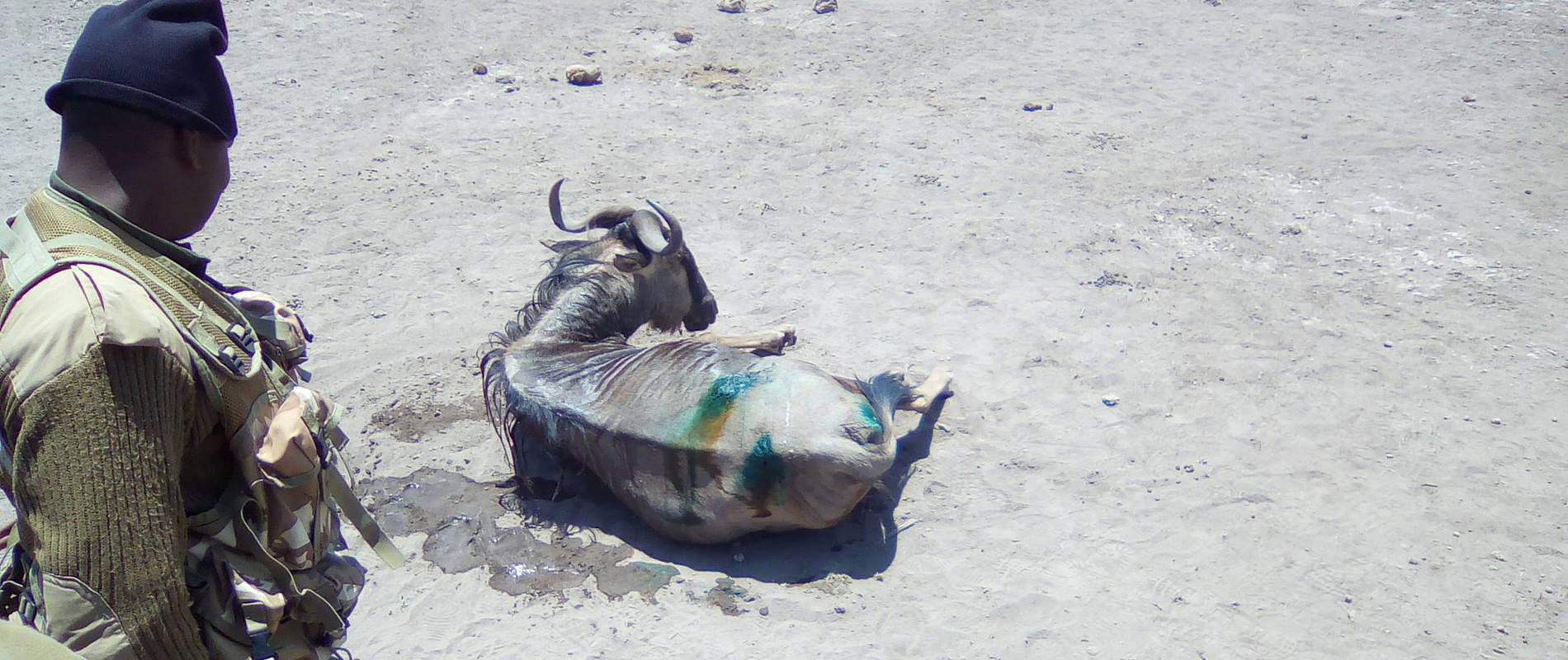Introduction September has been a hard month for wild and domestic animals
Introduction
September has been a hard month for wild and domestic animals. This has been due to the prevailing dry hot and dusty weather. Savannahs have been left with no grass and the hilly areas have no undergrowth. Water pans and temporary rivers have run dry. This has led to increased competition as both domestic and wild animals try to survive from the little resources available. As this happens some are unable to cope and die due to poor health, starvation and/or old age. This as a result has contributed greatly to deaths witnessed during the month.
Despite the drought it was encouraging to see there was hardly any human related injury to wildlife. This demonstrates the peaceful coexistence between humans and wild. We hope the same will continue in months ahead as we pray for rains to come soon than later.
1. CHEETAH CAPTURE
Date: 02/09/2017
Species: Cheetah
Sex: Male
Age: Adult
Location: Tsavo East National Park
History
A report concerning a stray adult cheetah was made to Amboseli Mobile Vet Unit by Community Warden Tsavo East National Park. The cheetah had invaded a goat boma at Ikanga just next to Mombasa Nairobi Highway killing two but only predating on one. At the site we joined the Problematic Animal Control Team (PAC) from Tsavo East National Park
Immobilization
It was found resting near drums’ shade within what appeared to be a contractor’s site. It darted using 150mgs ketamine mixed with 1mg Medetomidine topped up with 500 I.U Hyaluronidase in 3cc dart. It was approached using vehicle to avoid disturbance as the witnessing crowd was controlled PAC team. Dart was placed successfully on right thigh muscles effecting narcosis in five minutes. It was quickly retrieved from the drum area and carried manually by two men to a waiting trap loaded on a pickup so that it could be ferried to a suitable release site.
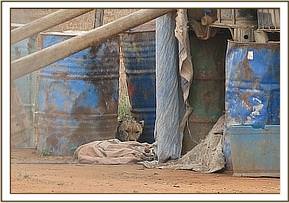

Off-loading, Treatment and Reversal
The release site was at Lugard identified for its’ habitation being adorned with suitable prey and water. The carrier vehicle was reversed near a green shrub preferred for its’ shade. The candidate was offloaded and placed under the shade. It was examined for any injury and found to have a penetrating wound at the right fore pawl medially. It had pus discharge. It was cleaned using Hydrogen Peroxide and Tincture of Iodine and then infiltrated with 5gms of Cloxacillin Ointment followed with Tetracycline wound spray topically. The body score was at level 2 taking 5 as well muscled and 1 as poor muscled. The belly was full since it had predated on the goat.
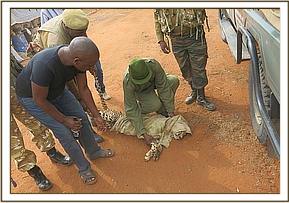

The area was cleared ready for revival. It was reversed using 7.5mgs Atipamezole into neck muscle in one syringe and in another syringe 30mgsDoxapram administered into scapular muscles to quicken recovery. We watched from a distance and the head was up in four minutes with full recovery at tenth minute. It got up and hid itself in the nearby thickets.
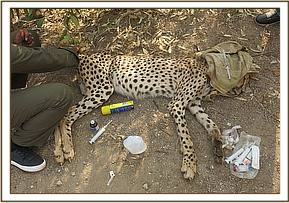

Prognosis
Assumed to be fair if it acclimatizes well to the new habitat.
2. LION TREATMENT
Date: 13/09/2017
Species: Lion
Sex: Male
Age: Adult
Location: Amboseli National Park
History
A report concerning an injured lion around ‘Western’ area was received from Amboseli Research Technician who had been informed by Tortilis Tourist Camp guide.
Immobilization
It was sedated using 375mgs Ketamine mixed with 4mgs Medetomidine in 3 centiliters dart. Remaining empty portion of the dart was filled with water for injection to make dart heavy for steady flight. It was approached using vehicle and this time rangers were instructed to be ready with guns just in case of any attack.
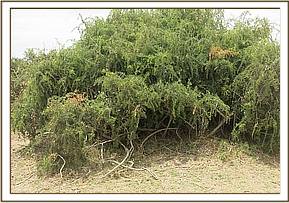

Examination
A blind fold was placed on the eyes. It was observed that before darting it was exhibiting panting due to high ambient temperature. It was fully engorged as depicted by swollen stomach indicating a good meal in less than twelve hours earlier. Examination revealed swollen pus discharging left elbow joint occasioned by what appeared to be multiple bite marks. This was assumed to have been caused by other lion(s) through territorial fights as their mating season culminates. This injury caused hopping lameness on the said limb as confirmed by the guide who spotted it. No any other injury was observed.

Treatment
The swelling was palpated for crepitation and to ascertain presence of pus pockets. Little pus could be expressed on pressing and there was no crepitation. Hydrogen peroxide was introduced using 20cc syringe into one of the most proximal bite injury. 10 grams of Cloxacillin antibiotic cream was infiltrated to all bite wounds followed by liberal Tetracycline wound spray topically. Systemically it was injected with 15mlInflaron and 20ml Dexamethasone as broad spectrum antibiotic cover and anti-inflammatory at different muscle sites. 8mgs Ivermectin was subcutaneously administered to cater for parasitism. Dart wound was infiltrated with 5gms of Cloxacilin antibiotic cream to cater for any sepsis and eyes to prevent damage.
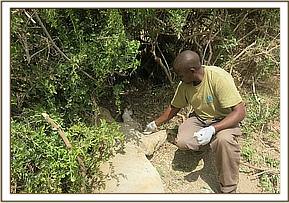
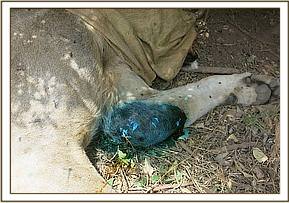

Prognosis
This was rated as favorable because despite the injury which seemed to be more than a week old he was fully engorged indicating that it was in away getting much needed nourishment hence ‘stress free’ recuperation period.
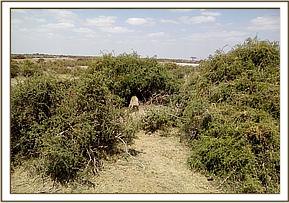

3. ZEBRA DEATHS
Date: 13/09/2017
Species: Four Zebras
Sex: One Male & Three Females
Age: Adults
Location: Amboseli National Park
History
Four carcasses were spotted by park security team on patrol who reached for the vet immediately. A surveillance on the cause of death was instituted thereof.
Postmortem observations
All carcasses were relatively fresh presumed to be about forty-eight hours old. All were virtually predated on completely and they were within same locality separated by a distance of a hundred meters from one another on different directions. All seemed skinny as depicted by noticeable bony prominences.
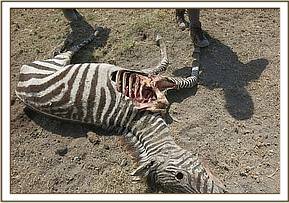
The canines were worn out exposing the sensitive canals at the middle while the molars were extremely worn down almost to the level of the gum. This primarily was thought to be the cause of poor health exacerbated by lack of palatable forage at this particular dry period.
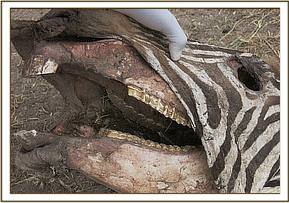

Patrols within the park are depicting animals in poor nutrition status some with pot bellies, emaciated and ventral edema. It is this time of weather challenge and poor nutrition that helminthosis becomes a factor leading to general malaise and incapacitation. Active surveillance will continue so as to pick any infectious condition just in case one strikes.
4. ZEBRA TREATMENT
Date: 15/09/2017
Species: Zebra
Sex: Male
Age: Sub adult
Location: Amboseli National Park
History
A casual worker while on his duty within the Amboseli Park called the Mobile Vet Unit concerning unwell zebra which was seen wobbling and drooling saliva with its open mouth. It could not keep pace with the rest of the herd and kept dull demeanor. A quick response was mounted.
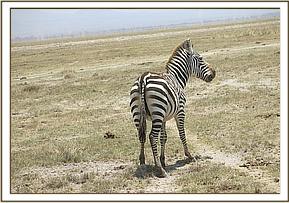
Immobilization
A 3cc dart consisting of 1mg Etorphine and20mgs Azaperone was prepared and used to sedate the animal. It was maintained under manual restraint as treatment was carried out.

Examination
A On the head there was buccal external swelling which depicted submandibular pitting edema. Within the gum, the capillary refill time was extended from one minute to about two and mucous membranes were pale. Inside the mouth cavity conspicuous was internal swelling on the left buccal side extending to left lower teeth gum line. It was tentatively diagnosed as having general lassitude as a sequel of anemia due to helminthosis compounded by poor nutrition due to the drought.
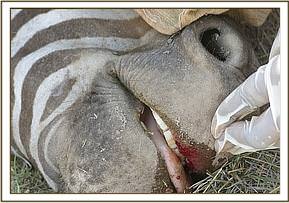

Treatment
The treatment was geared to cover the patient against secondary bacterial infections, install appetence and reduce parasite infestation. Among the different samples taken included whole blood in EDTA and plain tubes for microscopic slides and sera respectively, a tissue from right ear notch for post treatment monitoring as well as ticks from different regions of the body.
Prognosis/Update
It was graded as guarded because of severity of anemia and by the fact that it cannot offer self-defense (flight) from predator infested niche.


On 17/09/2017 a patrol was carried out and it was noted that the zebra had succumbed to shock as a result of severe anemia.
5. ELEPHANT RESCUE
Date: 18/09/2017
Species: Elephant
Sex: Female
Age: Juvenile
Location:Olongulului Group Ranch; Amboseli Ecosystem
History
The young elephant about four years old had been spotted by a community member within the ranch inside a drinking well about seven meters deep having water about three meters deep. The Unit set out immediately to rescue the elephant.
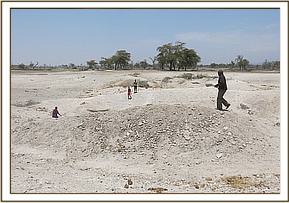

Rescue
Immobilization was dangerous and not an option since there was a possibility of the elephant drowning just in case it was fully sedated inside the waterhole. A quick thought was made to pull it out with the ropes and straps anchored on vehicle. An attempt was made to pull but the elephant was very heavy and risked strangulation. This was not to be.
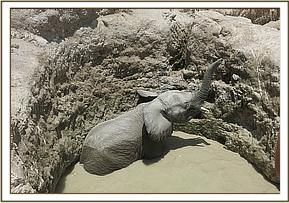

We thought and attempted to cut down one side of the well by digging but it was very hard due to stones. This also was not forthcoming. Instead we tried to create a slope for the elephant to climb out. We carefully threw in the well avoiding hitting the elephant all dead woods which were around, stones, and hard mud bricks from one edge to create a slope. We then placed the strap from front all the way round through the gluteal and manually by use of seven men tried to support it out as she climbed out. It was amazing how she easily and calmly she eventually came out. We left it under keen watch of the community ranch scouts as it trailed the family members.
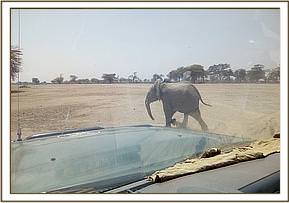

Follow-up
A call was made after three hours and by then the night was beginning to fall to confirm on the wellbeing of the elephant. We were assured that it joined the family successfully and were spotted near the Tanzania border on their way to what appeared to be Kilimanjaro National Park.
6. CIVET CAT RESCUE
Date: 18/09/2017
Species: Civet Cat
Sex: Male
Age: Adult
Location:Oltukai Lodge; Amboseli National Park
History
The cat was reported to be within the lodge premises by the Lodge manager to Amboseli Park Tourism Officer who subsequently informed the Vet Unit. The Vet Unit passed by on their way from rescuing young elephant.
Observation and Restraint
The manager was quick to point out that it had been in a fight with baboons as they scavenged together at a pit on lodge garbage. A blindfold was thrown over it but it was aggressive as it attempted to bite and escape. It was quickly cornered and blind folded followed by firm grip on its’ neck by one ranger and the other ranger held it at the tail base and hind limbs. It was ferried to the vehicle and secured manually to an appropriate release site within the park. It appeared lethargic probably because it was scared to feed near baboons after the fight and that wounds were septic.
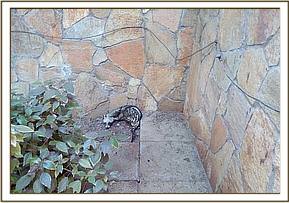

Treatment
Wounds were cleaned with Hydrogen Peroxide and Iodine. 5 grams of Cloxacillin antibacterial ointment was infiltrated in two wounds and tetracycline wound spray was generously topically applied. It was injected with 10ml Cyanocobalamin and 300mgs Flucloxacillin into different muscle sites. Another 2ml was injected subcutaneously for slow release as 60ml Sodium Chloride infusion water.


Prognosis
Guarded because of the poor body condition it was in and also incapable of resisting other predator attacks during convalescence time
7. LETHARGIC ZEBRA
Date: 19/09/2017
Species: Zebra
Sex: Female
Age: Adult
Location: Amboseli National Park
History
The Mobile Vet Unit was on effect of drought surveillance when it came across an adult zebra lying down and unable to stand up and flee on vehicle approach. Examination generally showed severe anemia through pale mucus membranes and degree of dehydration. For further observation it was euthanized and a postmortem conducted.
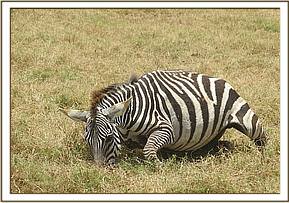

Postmortem observations
When cut open the large intestines and cecum were full of little thread red worms in thousands some free within lumen together with ingesta while others attached on the mucosa. The mucosal surface grossly depicted areas of hemorrhages, congestion, thickening/hyperplasia, erosion and some ulcerations and necrosis.


At the glandular stomach there were many stomach worms appearing like reddish conical outgrowths attached on the mucosa near pylorus resulting to ulceration and erosion of mucosa with concomitant hyperplastic kind of reaction around area of attachment.
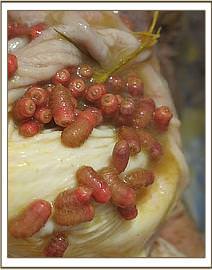
The above findings were also picked up in a postmortem conducted on the previous zebra case. Samples of various worms grossly seen free and others attached/embedded on/in tissues were taken for further analysis and identification.
Postmortem Diagnosis
These are instances of effect of heavy helminthosis exacerbated by adverse weather condition. Animal grow weak due to accompanying anemia, disturbance in digestive and absorptive function of the gut resulting to catarrhal enteritis of large intestines and as large worms migrate to/through mesenteries they predispose animals to colic, gangrenous enteritis, intestinal stasis, torsion, intussusception, ruptures with or without cerebrospinal involvement.
8. ELEPHANT DEATH
Date: 19/09/2017
Species: Elephant
Sex: Females
Age: Adult
Location: Amboseli National Park
History
The Mobile Vet Unit was on usual patrol when a call was received from Amboseli National Park Security team who were also on their patrol concerning a spotted a dead carcass within the park Odare area.
Postmortem observations
The carcass was under security team guard. It had two tusks intact. It was on right lateral recumbence. It was in the middle of decomposition and putrefaction with discharges flowing from it and different stages of maggots were observed. Foul smell was emanating from the carcass and especially from the areas where predation had been attempted. These areas included the trunk, upper and lower perineum. There was no appreciable point of external skin break or injury. The two tusks were easily retrieved from their sockets because of decomposition by hand pull.
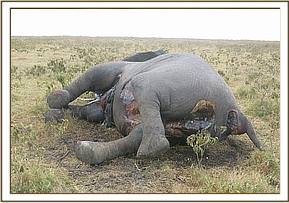

No meaningful postmortem exercise was visible because of decomposition. The carcass was aged as being at least four days old. Impression smears were made from the wet retrieved surface of the tusks for further analysis and rule out anthrax.
It was not possible to determine the cause of death. The elephant was approximated to be between 30 and 35 years old. Surveillance has been instituted so that any other carcass is picked while fresh for more meaningful findings to be carried out.
9. EMACIATED IMPALA
Date: 20/09/2017
Species: Impala
Sex: Male
Age: Adult
Location: Amboseli National Park
History
The impala had been observed by the Mobile Unit while on patrol as well as by tourists being very emaciated and with diarrhea. It had to be darted and if necessary sacrifice it for postmortem examination.
Immobilization
It was darted with 1mg of Etorphine and 20mgs of Azaperone because of its’ poor health condition. It took a little bit longer than expected which went up to ten minutes post darting. It was examined but decided to put it down humanely and carry on with postmortem.
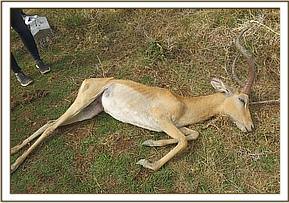
Postmortem observations
Whole carcass was thoroughly examined and important findings were from the liver and the kidneys. The liver appeared to have distended gall bladder. Further incision into the parenchyma particularly at bile ducts three stout ‘flagellated’ worms was recovered. The liver tissue was firm indicative of slight cirrhosis. Both kidneys were not easily appreciated as having cortex and medulla. Capture was sticking and not easy to pull but more importantly were the fluid filled sacs located at each pelvis. Each sac had whitish inclusion thus appearing like bladderworm. Dentition appeared normal and with two corner incisors still being temporary/milk teeth indicative of young adult ram.
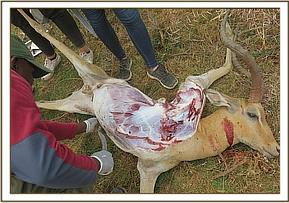

Postmortem Diagnosis
The emaciation was presumed to be one associated with vital organ failure particularly kidneys and liver. The diarrhea complicated the condition even further and was thought to be due to disturbance in these vital organs’ functions. Within same location there are two more male impalas showing various levels of severe emaciation. More findings will be conducted to compare the observations.
Various samples including whole blood in EDTA and plain tubes, ticks, worms and fecal were taken for further analysis.
10. ELAND POSTMORTEM
Date: 21/09/2017
Species: Eland
Sex: Female
Age: Adult
Location:Tawi Lodge; Amboseli Ecosystem
History
The dead eland report was made to the Mobile vet unit by Tourism Warden Amboseli National Park.
Postmortem observations
Carcass was found on right lateral recumbence partially submerged in waterhole just next to the lodge. Upon opening the carcass, there was congestion of the mesenteric circulations and coronary vessels. A lot of congestion was also observed in liver and lung parenchyma with clotted blood in the vessels. Lungs were not collapsed and there was marked gross interstitial partitions. The omentum, brisket, rectum, perirenal area and coronary groove were full of fat deposits. This denoted the good muscle cover/health the animal had before death. It was established that the uterus was gravid with a male calf seemingly within the second trimester of gestation.
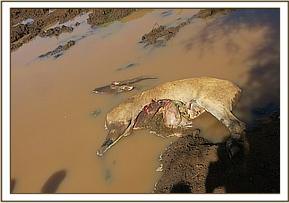
Postmortem Diagnosis
Two scenarios were in the picture. One that the animal collapsed on its’ own during day time while drinking water and second, the animal was attacked at the waterhole while quenching. This arose after more inquiries were made from the lodge personnel.
Nevertheless, an impression smear was made from the cut ear for demonstration purpose. Lodge personnel were instructed to be vigilant enough and report any death witnessed within the area for further exploration.
11. WILDEBEEST TREATMENT
Date: 22/09/2017
Species: Wildebeest
Sex: Male
Age: Adult
Location: Amboseli National Park
History
The animal was sighted by the Mobile Vet Unit while on its’ usual day patrol within the park. It was approached using vehicle only to find that it had a wound on the right ischium.
Immobilization
It was immobilized using 1.5cc dart in which a concoction of 6mgs Etorphine and 50mgs Azaperone. A blindfold was applied on the head to avoid external visual stimuli. It was checked and found to exhibit normal parameters under anesthesia. It was dowsed with cold water to control high ambient temperature effect on its body temperature.
Examination
The wound was examined and found to be a dry open wound about ten centimeters in diameter. Just nearby both on left and right rumps were penetrating wounds about five centimeters deep and appeared to have been due to teeth bites. They had dried but blackish discharge had dried as it flowed out and downward. It appeared to have survived lion attack. There was no any other unusual finding. The bull was in good health.
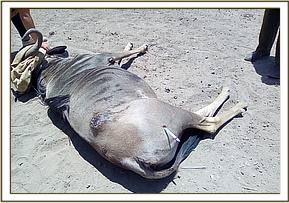

Treatment
Wounds were cleaned thoroughly using Hydrogen Peroxide and Iodine followed by topical spray with Tetracycline wound spray. Against secondary bacterial infections it was covered systemically with 6000mgs Tetracycline and 20ml multivitamin as metabolic stimulant into different muscle sites. 8mgs of Ivermectin was administered subcutaneously on the neck to act against internal and external parasites.
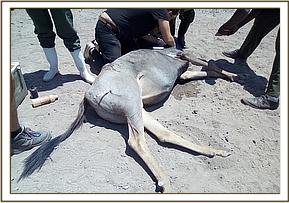
Prognosis
It has guarded prognosis before complete recovery because of inadequate ability to resist any forthcoming predator attack due to injuries. Otherwise upon complete recovery it will have favorable prognosis because it can escape attack by flight or fight.
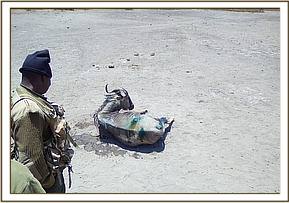

12. WILDEBEEST TREATMENT
Date: 23/09/2017
Species: Wildebeest
Sex: Male
Age: Adult
Location:Kimana Sanctuary;
History
While on a normal patrol within the Sanctuary we bumped into a wildebeest lying down on sternal recumbence isolated from others. An intervention ensued to determine the cause of its’ weakness.
Examination
It had heavy tick infestation especially on the neck and soft areas like groin and perineum. Mucus membranes were very pale depicting severe anemia. Dentition and general body status wasn’t an indication of any abnormality in mastication. More investigation needed to be done to establish the cause of severe lethargy. Various samples were taken including feces, whole blood in plain and EDTA tubes, ticks and microscope slide were made. It appeared that it could not survive for long before death because of poor prognosis exhibited. To that effect it was euthanized humanely so as to carry more observation by conducting postmortem.
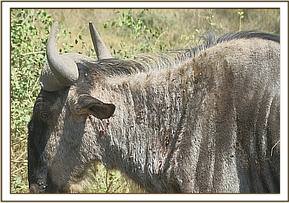

Postmortem Findings
The most striking feature after opening the abdominal cavity was marked pale mucosal surface of internal organs. All internal organs were examined and what struck the findings was the desiccation of the omasal contents. There was no coronary grove fat omentum had no fat.
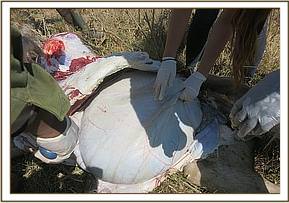
Postmortem Diagnosis
Tentatively the observed lassitude was presumed to be as a result of Anaplasmosis. A tick-borne protozoa disease causing omasal impaction and anemia. This would be further investigated by samples taken after they are processed.
Further surveillance will be planned and conducted with aim of monitoring the healthy status of other wildebeest within the sanctuary.
13. GIRAFFE BLINDNESS
Date: 23/09/2017
Species: Maasai Giraffe
Sex: Male
Age: Adult
Location:Supuko; Amboseli Ecosystem
History
The giraffe was reported by Amboseli National Park Community Warden as being stoned by young children who were following it from nearby Maasai Manyatta.
Observations
It was found under the guard of Big Life Foundation Area scouts who kept it away from the nearby crop farms where it was being chased. On close examination it was observed to have bilateral cloudy cornea and no lacrimation. This meant that the condition resulting to blindness was not acute but rather a chronic one. There were no self-inflicted injuries.
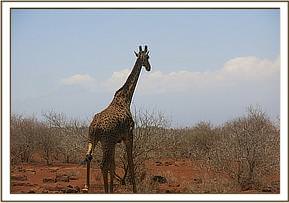

Conclusion and Recommendation
Prognosis was bad and the only best way to prevent the animal from plunging into gullies and valleys or get into crop farms within, it was decided to be euthanized. This would exempt the animal from human-wildlife conflict and the associated sufferings resulting from human inflicted injuries/ trauma.
A call was made to KWS Problematic Animal Control Team to take charge and euthanize by use of gunshot and ferry the carcass to park away from area residents who if left there would be converted into game meat. This was confirmed later to have been done meticulously by the team.
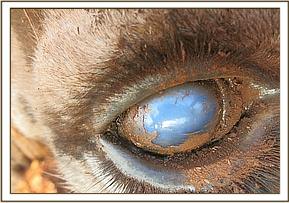
Both eyes were retrieved from the carcass for further examination. Both had complete corneal opacity appearing grayish.
14. SNARED GRANT GAZELLE
Date: 23/09/2017
Species: Grant Gazelle
Sex: Male
Age: Adult
Location: Mbirikani; Amboseli Ecosystem
History
The case was reported by KWS Loitoktok Station In-Charge to the Mobile Vet Unit who rushed there after attending to blind giraffe case above. It was found under keen watch of Big Life Foundation rangers. Attempt to desnare it ensued immediately.
Immobilization
A 3cc dart containing 3mgs Etorphine and 40mgs Azaperone was prepared quickly before eliciting unwarranted stress through our presence to the animal. It was to be immobilized remotely by use of Dan Inject gun through vehicle darting. It was not an easy task to be because of the terrain with many ‘Waitabit’ shrubs making area almost unmotorable.The gazelle was not used to vehicle and kept on running. Any attempt to foot dart was even worse as it was very scared to people on foot. An hour was spent trying to approach all in vain.
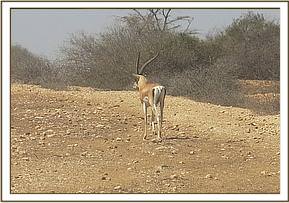
Conclusion
It was observed that the snare wire was not life threatening because it was barely tight around the neck, not strangulating though dangling down to occasionally entangle the hind limbs loosely. It was a nuisance but then darting the animal proved difficult. The exercise was curtailed to give it another try when the animal has settled at a later date once sighted again.
15. GRANT GAZELLE DEATH
Date: 25/09/2017
Species: Grant Gazelle
Sex: Male
Age: Adult
Location: Amboseli National Park
History
While on surveillance patrol within the park the Mobile Vet Unit spotted vultures dropping down on the ground indicative of a carcass. We drove near only to discover a fresh carcass of a grant gazelle. It was still warm meaning it had just died. Its’ eyes had been gorged out, its’ perineum and testis had been predated on by the vultures. It was on left lateral recumbence. A postmortem ensued to establish the possible cause of death.
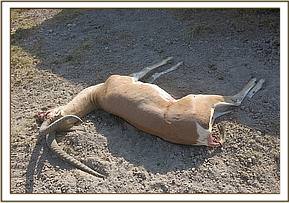
Postmortem observations
No important finding were observed in the vital organs except in glandular stomach wall the abomasum especially near pylorus. There was numerous reddish swelling of varying sizes appearing tumorous more appreciable on the visceral surface. When cut open they discharged reddish thick discharge (necrotic material) together with many long reddish worms. When inspected further some were found to have ruptured spilling their content into peritoneum. The left kidneys’ pelvis area appeared to have an abscess appearing like a bladderworm. The caecum had tinny whitish worms on the mucosa. The omentum was membranous with no fat but with several sticking fluid filled sacs appearing to have white inclusions indicative of parasitic cysts.
Postmortem Diagnosis
The gazelle appeared to have succumbed to shock as a result of fatal peritonitis which was secondary to tumor-like swellings rupture on stomach wall and migration of worms. This is an indicative of heavy parasitism wreaking havoc especially at this time when there is little to feed on due to prevailing drought making animals susceptible to helminths associated complications/deaths.Samples were taken especially of the various worms seen grossly for further identification/study. Patrols will be intensified so as to pick the carcasses while still very fresh and perform meaningful postmortems so that any infectious cause of death if any will be noted early for collective measure to be taken.
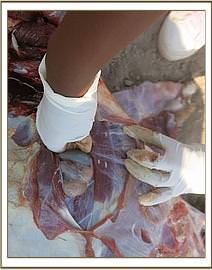
16. GIRAFFE FOAL RESCUE
Date: 26/09/2017
Species: Maasai Giraffe
Sex: Male
Age: Foal
Location: Amboseli Camp Site bordering Amboseli National Park
History
A report of a young giraffe needing rescue was received from Amboseli National Park administration.
Ante mortem Observation
It was found on left lateral recumbence under watch of Amboseli camp site attendants as community members looked on. The attendants had tried to administer water by mouth with little success. The naval remnant was still attached at umbilicus meaning it was less than 48 hours old. Little sporadic tremors were observed on all limbs some in synchrony others out of synchrony. A blind fold was placed on the head to minimize stress as examination ensued. It was carefully loaded to the pick-up and ferried to the park HQ for more examination. It was subjected to further examination in order to take an informed measure as how to manage the case. It was placed on right lateral recumbence. Efforts to straighten its’ neck were unsuccessful and also it could not maintain sternal recumbence on its’ own. By this time more pronounced tremor/jerking of limbs were observed. It was concluded that it was in poor state as depicted by generalized incoordination. It was euthanized humanely and postmortem carried out.
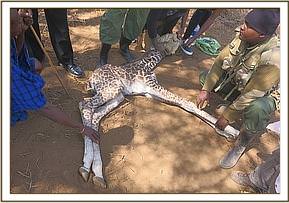

Postmortem Diagnosis
It appeared the animal plunged into a ditch and sustained hemorrhage to the brain after contusion of the cranium. The reddish fluid was plasma which separated from blood clots observed on the cerebral cortex. This intracranial bleeding may have resulted to increased intracranial pressure leading to expression of central nervous signs antemortem observed. It is this damage to brain that interfered with initiation and coordination of all voluntary activity of the body as observed primarily as quadriplegia, spontaneous tremors and neck flexion. This animal could have been trying to evade or escape from danger posed by humans/dogs/baboons when it fell.
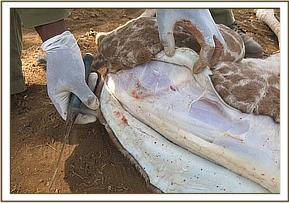
17. LESSER KUDU RESCUE
Date: 27/09/2017
Species: Lesser Kudu
Sex: Male
Age: Adult
Location:Naisuyati; Amboseli Ecosystem
History
The Mobile Vet Unit received a call from Loitoktok KWS Station Warden concerning a kudu which had plunged into a dry well intended for irrigation. Rescue mission got underway immediately.
Observation
The dry well is situated on one edge of an irrigated tomato farm. The well was about twenty feet deep and was wide enough because the adult kudu was found in standing position freely. It was aware of human noise and got afraid at first. Noise was minimized as we planned on how to pull it out of the well using ropes.
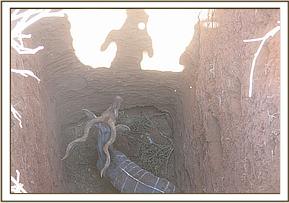
Rescue
Immobilization was not necessary because we thought of dropping a long lope with a snoop at one end with aim of looping the horns. The other end was tied on a vehicle. First trial was not successful but the second trial hooked on left horn. The snoop tightened at the base of the horn and it was fine to give a quick pull out. Four able men were used to quickly retrieve the animal as one man waited at the well entrance to grab the two horns in order to effect manual restraint. It worked perfectly and on earth surface it was pinned down in right lateral recumbence. A towel was placed on the eyes to minimize visual stimulation as examination ensued.
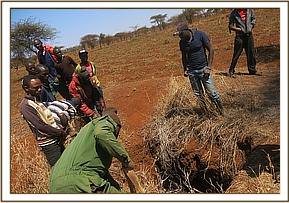


It had skin abrasions on its’ back and limbs which were thought to be as a result of struggle to get out of the well.
All skin abrasions were sprayed topically with Tetracycline wound spray.
Release
It was taken about ten meters away from the well and let go by releasing the horns. It quickly and energetically sprung up and took to the nearby thickets. The farmers who had come to witness were instructed to secure the dung out wells with chain links or timber off-cuts or with thorny cut-off branches because they are risky to humans and animals whether domestic or wild.
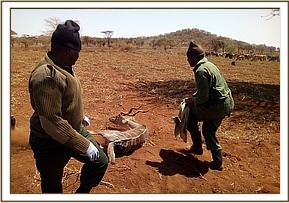

Prognosis
Good because it was healthy with no obvious physical incapacitation.
18. SURVEILLANCE INTO DEATHS OF ZEBRAS AND GRANT GAZELLES
Date: 28-30/09/2017
Species: Zebras and Grant Gazelles
Sex: Males & Female
Age: All Ages
Location:Akilomatian and Shompole Group Ranches
History
The report of zebra and grant gazelle deaths was made by KWS Assistant Director Southern Conservation Area to the Mobile Vet Unit based in Amboseli National Park on 26/09/2017. A consultation with Area KWS Station ensued with aim of gathering as much information as necessary concerning the deaths. This was important for ensuring the surveillance exercise planned would be a success. After full consultation the surveillance exercise was planned to take place between 28th and 30th of September 2017. The area was visited on the said dates and a thorough search for carcasses was mounted. The carcasses found which were relatively fresh were subjected to postmortem procedures, old carcasses were documented and some of seemingly sick/weak/emaciated animals were subjected to euthanasia followed with Postmortems while others were treated and released for post treatment monitoring
Documented old carcasses
15 carcasses were highly decomposed and/or predated on that no meaningful postmortem was carried out on them.


Documented fresh Carcasses
These carcasses supported meaningful postmortem procedure to be carried out
Carcass Species
Carcass location
Group Ranch
Carcass Sex
Carcass Age
Dead Animal Age
Grant Gazelle
37M 0180384 UTM 9790380
Olkiramatian
Male
Less than 48 hrs
Subadult
“
37M 0182011 UTM 9785945
Shompole
Female
Less than 12 hrs
Adult
“
37M 0181255 UTM 9786129
“
Female
Euthanized
Subadult
“
37M 0182194 UTM 9785708
“
Male
Less than 24hrs
Adult
Zebra
37M 0185311 UTM 9770319
“
Male
Less than 36hrs
Subadult
Sheep
37M 0185372 UTM 9777510
“
Female
About 48hrs old
Adult
Grant gazelles: important postmortem findings
Rigor mortis was observed in all carcasses and there were no discharges from body orifices. All carcasses were in good health as depicted by fats on omentums and good muscle cover. All carcasses had both striated and soft muscles hemorrhages of different sizes. Striated muscles had large patches of hemorrhages while soft muscles of heart and aorta had petechial and pinpoint forms on the outer surface. Heart on the inner surface had patches of hemorrhages. Small hemorrhages were observed on the serosal surfaces of rumen and lungs. The lungs of relatively old carcass had diffused congestion with bloody tinged foam within the respiratory tree. In all carcasses there was severe omasal impaction depicted as highly desiccated omasal content causing mucosal erosion upon retrieval attempts. The abomasums were devoid of ingesta except traces of sand precipitates but the mucosa had pin point hemorrhages. The small intestines had no ingesta or ruminal content as would be expected but rather had little mucoid contents. All livers were dark due to high congestion oozing blood when cut. The gall bladder serosal surface was reddish due to congestion. There was markedly congestion of mesenteric vessels. Spleens were not swollen neither mottling hence appeared normal. All kidneys were congested. The meninges depicted hemorrhages on the surface and brain vessels were congested.
One grant was found on right lateral recumbence minutes before death. It depicted heavy grunting and peddling of all four limbs with quick and deep breathing. This pre-death period was very stormy and as it was observed in other found dead carcasses signs of struggle before death. It was euthanized and postmortem done.
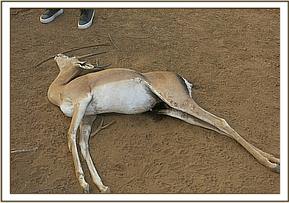
One grant was found lying down on sternal recumbence and when approached it sprung out showing quick short spells of galloping with signs of lethargy. It was approached from behind quietly and caught manually. It was observed to be grunting and breathing heavily with mouth open. It was given poor prognosis though it was treated with 3ml Flunixin Meglumine intramuscular, 6mgs Ivermectin subcutaneous, 7500mgs Amoxicillin intramuscular and 100mgs Cyanocobalamin intramuscular. It was dowsed liberally with cold water to cool it down and sprayed with Green Spray to act as post treatment monitoring mark.
Important postmortem Findings in Zebras
Only one zebra was fresh for postmortem. The carcass was less than twenty-four hours old and of a yearling male foal in poor muscle cover. Mucus membranes were very pale. When cut open, omentum was devoid of fat deposits as well as coronary grove. Thread like worms were found in the peritoneal cavity while others were observed as gray spots and reddish nodules on serosal surface of the cecum and large colons. When cut open the gradual stomach especially at pylorus and duodenum heavy infestation of stout reddish pear-shaped worms was observed. In the small intestine there were long tapes like worms appearing as whitish intestinal content from serosal surface. The open cecum yielded many small reddish worms in the lumen mixed with intestinal content while the mucosa was thickened with nodules discharging necrotic whitish material some mixed with many thread like worms sprouting from ulcerated ones.
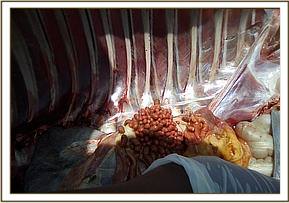
Samples Taken
All carcasses on which postmortems were done had impression smears done from cut ears discharges. The two grants (treated and euthanized) had whole blood taken in EDTA and plain tubes for sera and whole blood harvesting. From both also thin and thick microscopic blood smears were done for laboratory analysis and examination.
Analysis is underway at KWS laboratory.
Postmortem Diagnosis
For grant gazelles the pathologic changes observed seemed to involve largely the circulatory systems resulting to cardio-respiratory embarrassment while for the zebra it seemed to involve the digestive system. For the grants an infectious cause is presumed to be the cause of the deaths while zebras’ deaths are probable effect of heavy helminthiasis exacerbated by adverse weather condition and accompanying poor health.
Important Information
OLKIRAMATIAN & SHOMPOLE GROUP RANCHES
Due to prevailing dry condition all wild and domestic animals have concentrated around the swamp area. This is because there is virtually no undergrowth both in dry and wet seasons grazing areas.
Laboratory Results
The results unanimously yielded tick-borne diseases as intracellular hemiparasites. The predominant ones were Anaplasma and then babesia. The Postmortem findings in correlation with laboratory results centres in for anaplasma. Deaths noted are thought to be due to susceptibility of Grants to anaplasma exacerbated by weakened immune system due to prevailing weather condition.
Way Forward
The situation should be monitored for at least two weeks with the aim of revisit for sampling and further surveillance if deaths continue. Meanwhile pastoralists should be encouraged to effectively control ticks on their livestock through spraying. This is very important as ticks transmit the disease to both domestic and wild animals. Ticks population is favored by hot conditions as witnessed currently.
